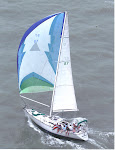White
Pepper was nearing the end of
the season by early June. We had spent a delightful several weeks in
the Abacos seeing old haunts and old friends. Sister, Susan, and
niece, Emma, flew in for a whirlwind visit. We were able to have two
long stretches at Treasure Cay, one in the company of new friends
Bill and Mary Ellen from Sea Escape.
Sandra and Jens from Kobald
were able to stop by for one day at Marsh Harbor before tearing off
through the Man-o-War Channel headed for the Chesapeake Bay. They
made it 6 days later without problems.
However,
the Bahamas in the summer is for power boaters who can quickly duck
back to Florida or for sail boaters who have a credible hurricane
plan. After all, Hurricane Matthew had just devastated this part of
world only 10 months earlier.
Dreading
another hot slog up the ICW White Pepper
resolved to take the East Coast of Florida in one jump. In 2015
White Pepper had made
a last stop at Grand Cay in the NW corner of the Bahamas before
jumping off through the nearby Walker Cay Channel for the St. John's
River. That trip worked out very well mostly because of a marvelous
weather window. We wanted to try this route again.
Robert Briscoe
Susan, Emma, and taxi driver
Sandra and Jens
Good
friend, Robert Briscoe, flew in to help and get his first Gulf Stream
crossing. A weather window opened up for the middle of the week.
Although the winds would be from a favorable direction they could be
too light. And thunder storms were likely as they almost always are
this time of the year in Florida.
Fortunately,
White Pepper, still
had the extra diesel jerry cans from the Ragged Island trip. I
calculated that if we could sail all of one day we could motor the
rest of the way. If there was no wind, we had enough fuel to motor
to Cape Canaveral.
White
Pepper topped up fuel at Marsh
Harbor, Great Abaco Island and there also filed a float plan over the
internet with the US Customs and Border Patrol. The float plan would
allow us to clear customs in Florida with only a phone call.
Next
stop was Treasure Cay again, then around Whale Cay Passage to Allen's
Pensacola Cay. We had to motor most of that day. From Allen's
Pensacola Cay is possible to gain the Atlantic through a nearby
passage, but we chose to stay on the Little Bahama Banks as long as
possible. We headed West for Grand Cay about 50 miles away. The
wind lightened and we again had to motor. About 4 miles short of
Grand Cay White Pepper
left the dotted line and headed for Walker's Channel. We elected to
skip Grand Cay in order to get Robert back in time to catch a
scheduled flight.
Whale Cay from offshore
Hurricane
Matthew may have moved some sand around last year changing the
channel. However, by going from way point to way point as recommend
in the Waterways Guide to the Bahamas, we never saw less than 11 feet
depth. By coincidence we were leaving at low tide. However, I could
clearly see some shallow spots between the center of this wide open
channel and Little Walker's Cay several miles away.
Upon
leaving the banks the wind picked up nicely and White
Pepper could sail freely and
fast. It was about 6:30 pm so we had 2 hours to settle down before
sunset. A huge crackling thunderstorm started about 10 miles away.
It slowly moved off to the North West away from us (traveling North
by North West). The night watches were quiet, pleasant and passed
quickly. By 3 am the stars and the nearly full moon were shining down
as a gentle breeze pushed us along.
Dawn, the photo does not adequately show the subtle colors
My
game plan was to cross the Gulf Steam in the morning before the
thunderstorms picked up. So at dawn White Pepper
started her motor and headed due West. We crossed the axis at noon in
conditions so benign that Robert joked he would have to have a repeat
trip to earn his stripes. The GPS was recording speeds of 8 to 10
knots. Later in the afternoon the wind filled in from the South West
as predicted, and we could sail until sunset. There were
thunderstorms in the distance, but none came close. From there on it
was a brisk motor all the way to the St. John's River jetties. Part
of the hurry was to arrive in time for the flooding current. We
cleared the jetties at 1:30 pm with 2 or 3 knots of incoming current.
We had done 240 miles in 32 hours. Curiously, on the St. John's River
maximum flood current is at low tide and slack water is at mid tide.
We were quickly carried up to Jacksonville docking at our regular
spot in the free Jacksonville Municipal Marina. We tied up at 5:30
pm in the shadow of the Jacksonville Jaguars football stadium. This
was almost 16 months after we had departed from the same slip so long ago.
The next day was an easy motor, albeit in the rain, to White
Pepper's haul out destination
Green Cove Springs Marina.
Downtown Jacksonville, rain cloud overhead and Main Street Bridge in center.
This
post may seem overly long and detailed, but I wanted to make some
points for anyone planning a similar trip. First, get some north
miles the first night, cross the Gulf Steam early on the second day,
and finish the trip along the coast during the second night and early
the next day. Also be mindful of the strong currents in the St.
John's River. White Pepper
was pleased to learn that Sea Escape followed
the same route two weeks later with no problems.
Favorable current
The Q flag, barely needed with local boater's option at C&BP
Easy trip























































